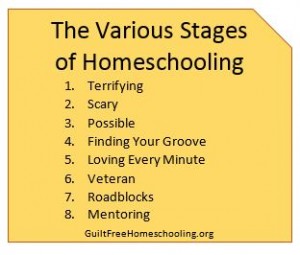Mental health improves as students learn to think for themselves and trust their own instincts, instead of relying on other students to give the right answers.
Physical health improves with less exposure to the germ-factory classrooms. My children suddenly stopped having continuous colds and conjunctivitis (pink-eye), when we switched from public school to homeschooling.
Emotional health will be calmer with a routine at home, instead of the unpredictable chaos and fear in the public classroom.
You will know exactly what your children are doing and learning each day. You can focus in immediately on whatever they may struggle with and resolve it, rather than waiting to be surprised with the news at a parent/teacher conference, weeks or months later.
Your family will be much stronger as one cohesive unit, because closer relationships naturally develop when parents and children work together. Your children will learn valuable life skills and independent learning skills that they will use for years to come.
Your child will be able to concentrate on topics of his own interest, because 1) he’s not surrounded by 20-some other students, all clamoring for attention, and 2) the freedom provided by homeschooling’s more efficient use of time gives him the opportunities (both in time and energy) to look into new interests.
It is personally rewarding to see what has been learned, whether evaluated on a daily, weekly, monthly, or yearly level. Children (as well as parents) grow in confidence, when they recognize their own accomplishments.
Other titles in this series:





 Guilt-Free Homeschooling is the creation of Carolyn Morrison and her daughter, Jennifer Leonhard. After serious disappointments with public school, Carolyn spent the next 11 years homeschooling her two children, from elementary to high school graduation and college admission. Refusing to force new homeschooling families to re-invent the wheel, Carolyn and Jennifer now share their encouragement, support, tips, and tricks, filling their blog with "all the answers we were looking for as a new-to-homeschooling family" and making this website a valuable resource for parents, not just a daily journal. Guilt-Free Homeschooling -- Equipping Parents for Homeschooling Success!
Guilt-Free Homeschooling is the creation of Carolyn Morrison and her daughter, Jennifer Leonhard. After serious disappointments with public school, Carolyn spent the next 11 years homeschooling her two children, from elementary to high school graduation and college admission. Refusing to force new homeschooling families to re-invent the wheel, Carolyn and Jennifer now share their encouragement, support, tips, and tricks, filling their blog with "all the answers we were looking for as a new-to-homeschooling family" and making this website a valuable resource for parents, not just a daily journal. Guilt-Free Homeschooling -- Equipping Parents for Homeschooling Success!

Recent Comments